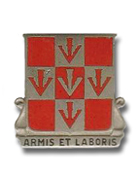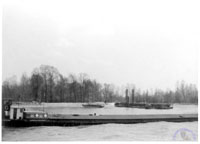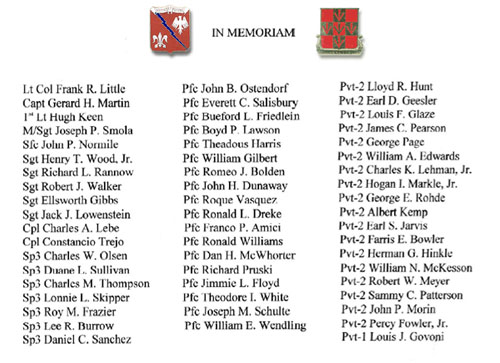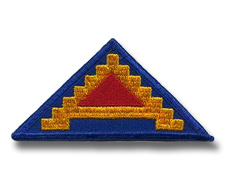If you do
NOT see the Table of Contents frame to the left of this page, then
Click here to open 'USArmyGermany'
frameset |
499th
Engineer Battalion
555th Engineer Group
Looking for more information from military/civilian
personnel assigned to or associated with the U.S. Army
in Germany from 1945 to 1989. If you have any
stories or thoughts on the subject, please contact me . .
|
|
|
|
|
| |
| 1402nd
Engineer Bn History |
|
| 195.
- 1955 |
| The 1402nd Engr
Bn (Cbt) was a California National Guard unit. It was released from
for active federal service on 17 January 1955 and replaced by a Regular
Army unit, the 499th Engineer Battalion (Cbt), which was activated
on the same date with all changes made less personnel and equipment. |
|
| |
| 1955
|
| (Source: THE
MILITARY ENGINEER, Sep-Oct 1955) |
|
Bridging
the Rhine
By 1st Lt. Richard A. Finke
In conjunction with a 280mm cannon crossing and field forces tests,
three Class 60 floating bridges were constructed in 1954 across
the Rhine River in the vicinity of Speyer, Germany, by the 1402d
Engineer Battalion (Combat). The length of each bridge
was approximately 780 feet.
Construction was from the west to the east bank. Assembly time was
measured from the start of raft assembly to the passage of the first
vehicle. The assembly times were, respectively: 6 hours and 50 minutes,
4 hours and 30 minutes, and 4 hours and 10 minutes. The time element
was important because of the heavy commercial traffic on the Rhine
River. Therefore, each bridge was assembled on a Sunday morning
and taken out of the river that same afternoon. Approximately 600
men participated in each exercise. The battalion had other mission
commitments at the time and had to recruit an additional 100 men
from separate companies under the 555th Engineer Group (Combat)
to supplement the building crews.
|
 |
|
The assembly of the bridge started with the construction
of four-float rafts at sites on a backwater downstream.
Six sites were used for each bridge operation. At two
of the sites the far-shore and near-shore reinforced end
sections were assembled while at the other four sites
four-float rafts were assembled. Deadmen for the high-line
towers, high-line cable, 45-degree cables to the bridge,
and bridge end sections were placed the night before.
The building began at dawn and started with the rolling
of the deflated pneumatic floats off the bridge trucks.
Six cranes, six air compressors, and ten powerboats were
used for the operation.
While rafts were being assembled, another crew was assembling
a high-line tower upstream. The highline cable was then
ferried across the river and attached to a deadman on
the east bank. It was pulled out of the water on the west
bank by a D7 bulldozer. |
|
|
The assembled
nearshore end section of the bridge was floated out of the backwater
and pushed upstream of the site by powerboats. While upstream of the
bridge site a raft delivery crew dropped the anchors from each float.
The end section raft was then backed down from the anchor settings
and swung into the prepared abutment site with the aid of the powerboats
which then shuttled back and forth, bringing out the completed four-float
rafts. They were anchored upstream of the bridge site by the same
method employed with the end section raft.
Powerboats floated the far-shore end section into place while the
bridge was being assembled from the near-shore. A D7 bulldozer was
ferried across on the far-shore end section and driven off onto the
prepared abutment. The bulldozer blade was attached to the end section
and used to move the section in and out so that the assembly crew
could pin the last raft in place.
While the rafts were being assembled to the bridge, another crew was
placing 45-degree guyline cables upstream and downstream of the bridge
and attaching rope lines from the upstream floats to the high line.
Downstream anchors were also placed from every third float. These
anchorages kept the bridge in alignment so that the last connecting
raft could be easily put in place.
Many problems were encountered. Bad roads at the raft assembly sites
had to be constantly maintained. Communications, supply, and maintenance
problems had to be dealt with. The training and break-down of crews
for the raft assembly sites, end section sites, bridge site, deadman
construction, abutment construction, highline tower assembly, and
raft delivery were finished the week before the operation.
The highlight of each bridge-building exercise was the crossing of
the 280mm cannons (Figure above). The Class R^ Pride proved that it
could pass the heavy load with ease. |
|
| |
| (Source: Email from John "Jack" Clarke, Co "B," 1402nd Engr Bn (C)) |
I was searching the Web yesterday and I saw the article about the 499th Engr Bn. It brought a lot memories for me. I was at Phillips Barracks in Karlsruhe from December 1952 till April 1954. I was in Company B of the 1402nd Engr Bn (Cbt) as Platoon Leader of the First Platoon. This was the bridge platoon for the floating bridge at Germersheim. I was bridge officer for the entire year of 1953 (I was the only 2nd Lt. the battalion) and I was in charge of a number of "swings". I have a number of photographs of the bridge.
Twice I failed to "swing" the bridge; once when the Rhine flooded and one we couldn't get the "mules" to start because of the cold weather.
I remember having a "duck" sink during one bridge swing. My platoon built the the first barracks on the west side of the river on pilings.
For years I have wondered about whether I knew any of those who died in the crash of the two C-119s. The article about the air disaster told me I did not.
Thanks for bringing back some interesting members.
|
|
| |
| (Source: Email from Rodney Gant) |
I was drafted into the Army on June 19, 1953 during the Korean conflict. Fortunately, the conflict ended before I got out of basic training (AAA at Ft. Bliss in El Paso, TX). Consequently, most of the guys in my unit went to various assignments in Europe. I went to Germany.
I was stationed in Karlsruhe, Germany, at Phillip’s Barracks from February 1954 to April 1955. I was in the 1402 Combat Engineer Battalion which was a part of the 555 (Triple Nickel) Engr Gp. On January 17, 1955 the 1402 colors were returned to California and the unit was replaced by the 499 Combat Engineer Battalion, which continued as a part of the 555 group.
Each Company in my Battalion (except headquarters company) had its own permanent floating Bailey bridge on the Rhine River, and each month, one platoon from each Company would go to their respective bridge to maintain it for a month. My company had the one at Brühl. On the first Sunday of most months, all of the traffic on the Rhine River was stopped so that we could practice “closing” and “opening” the permanent bridge, while at other times, we would practice building a rubber pontoon bridge across the Rhine. On one occasion, we beat the record for bridging the Rhine. It was slightly less than 5 hours, and was a 52 pontoon, 60 ton, class m-4.
On the occasion in which we broke the all time record, before we disassembled the bridge, our Group Commander had a helicopter land where we had assembled into a large circle. Over a p.a. system he announced “Men, I am pleased, but not satisfied”. We were back out there building it again on other occasions, but we were so disappointed and discouraged at his statement, that we never again even tried to beat our own record.
On one occasion we built the same type bridge but put twice as many rubber pontoons under it in order to see if it would support the 280mm atomic cannon. That was the first time that the 280 had crossed a floating bridge. The floats looked like they were about to submerge, and I’m sure the 280 drivers---two prime mover drivers, 1 pulling and 1 pushing--- didn’t feel too good about it either.
We also upgraded our Bailey “swinging bridge” at Bruehl to a “Double Bailey”, in order to accommodate the 280.
I drove a 2½-ton “deuce and a half” dump truck, and pulled a small trailer of explosives when we were on maneuvers. When we had an “alert”, several vehicles from our unit would go to the west side of the main highway bridge at Mannheim and wait along the banks until the alert was over. Our objective (if needed), was to blow out one section of the bridge. They always stressed the importance of not blowing up the abutments on either end because it would require so much work and time to replace them, as opposed to replacing/repairing one of the sections.
Each year, our Company would have a joint training exercise with the Air Force, and several C119 Flying Boxcars flying in formation would take our Company up for a training flight. I participated in the mission in 1954. I rotated back to the States in April 1955, and 4 months later, on August 11, 1955, after taking off from Echterdingen Field, about 20 miles west of Stuttgart, one of the C119s had engine problems, causing it to collide with another one and they both crashed in the Black Forest. There were 55 or 56 (depending on the source of information), in my company that were killed. All were from the 499 Battalion, 555 Group, and (10 or 11) were killed from the 10th Troop Carrier Squadron, 60th Troop Carrier Wing at Rhein-Main Airbase. At that time, that was the fourth worst military air disaster in history. One soldier in my squad wrote and told me that the only reason he wasn’t on one of the planes was that he had been injured while practicing “high jumping”, in preparation for competition between Army units.
On several occasions I had tried to find information on the internet regarding my old units, but the information was somewhat skimpy. But this past Saturday I went to see the Saint Patrick’s Day parade on Greenville Ave. in Dallas. I like to get to parade staging-areas early to see the various floats and equipment and mainly to talk with the people who will be in the parade. One man owned a DUWK, painted in traditional O.D. color with Army insignias. We talked about it as we related our common interest in the vehicle. I told him that I had worked many hours on and around DUWKs while building and maintaining bridges on the Rhine River. Until I told him, he was unaware that they were also designed to carry a Jeep. When I got home I begin looking for them on the internet, and accidentally pulled up DUWKs being used by my old unit. What a pleasant surprise that was! Thank you for the time and effort you have spent creating this web page.
|
 |
|
| |
| 499th
Engineer Bn History |
|
| 1955
- 1957 |
 499th Engineer Bn (Cbt) DUI
499th Engineer Bn (Cbt) DUI |
|
|
If you have more
information on the history or organization of the 499th Engr Bn, please
contact me . . |
|
|
|
|
(Source:
Email from Earl
W. Watson, C Co, 499th Engr Bn (C))
|
 |
|
I was stationed with Charlie Company, 499th Engr. Bn. (C) from March 1955 to February 1957. Our mission at the time was to maintain three floating bridges at different locations on the Rhein River and to provide engineering support throughout Germany. We were stationed at Phillips Bks., Karlsruhe, Germany. Our parent organization was the 555th Engr. Gp. (C), also based at Phillips Bks.
On 11 Aug 1955, two C-119 Flying Boxcars with 56 men from the 499th, collided in midair over the Black Forest near the village of Edelweiler, Ger. All personnel on both planes were killed. There was a total of 56 men from the 499th Engr. Bn. (C) and 10 Air Force crewmen on both planes.
In February 1957, the 499th Engr. Bn. (C) relocated to Ft. Benning, GA and was replaced in Germany by the 78th Engr. Bn. (C) under "Operation Gyroscope". The 499th was deactivated at Ft. Benning, GA in 1958.
I do not know the complete history of the 499th Engr. Bn. (C) but I believe they received nine battle streamers during World War II. Was deactivated sometime after the war and was reactivated and sent to Germany in the early 1950s. I have an old copy of a weekly paper ("The Water Log"), that was published by the 499th. It is a special edition published on 31 Aug 1955 in memory of the 56 comrades who lost their lives in the tragic accident of 11 Aug 1955. This paper lists the names of all 56 men. |
|
|
|
I was reading the history of the 555th Engr. Gp. (C) and on the
same page there was an article about the 1402nd Engr. Bn. (C) in
1954. I'm not familiar with the 1402nd but it seems to me that the
499th was redesignated from another designation prior to my arrival
in Germany. Could the 1402nd be the prior designation of the 499th?
The reason that this is confusing to me is that when I got there
we had three floating bridges on the Rhein River. These three bridges
were semi-permenant with approximately 3/4 on one side of the Rhein
and the other 1/4 on the other side of the Rhein (See attached photo).
These sections of bridge were mounted on fully enclosed metal pontoons
and when not in use, were stowed parallel with each bank of the
Rhein. This allowed civilian shipping up and down the river. One
of the bridges was constantly maintained by a platoon from C Co.
499th Engr. Bn. (C).
Every other Sunday each side was swung and pinned in the middle
allowing access across the river. One of our bridges was near Speyer.
These were class 60 floating bridges and could handle the load of
the 280mm Atomic Cannon and the cannon's movers. The time frame
between when the 1402nd Engr. built the floating bridges on rubber,
inflatable pontoons and when I arrived in the 499th Engr. Bn. makes
this a little confusing to me. However, I have no reason to doubt
the validity of the role that the 1402nd played.
|
| |
|
| |
|
499th Engr Bn
Bridge site |
|
|
|
|

1. Class 60 float bridge (KB)
|

2. Barge passes bridge site (KB)
|
|
|
|
 |
|
| |
| |
| |
| |
|
 499th Engineer Bn (Cbt) DUI
499th Engineer Bn (Cbt) DUI





